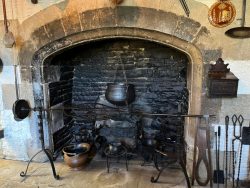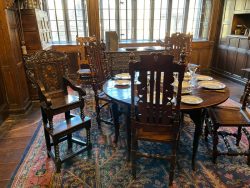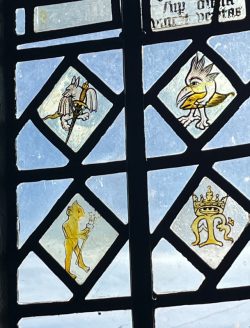 AS the second season of Gentleman Jack returns to our screens, the interest of the audience will once again turn to Shibden Hall, the beautiful Tudor house where Miss Anne Lister grew up, and where she lived with her aunt, uncle and sister – when she wasn’t travelling, usually with her lover and wife, Ann Walker.
AS the second season of Gentleman Jack returns to our screens, the interest of the audience will once again turn to Shibden Hall, the beautiful Tudor house where Miss Anne Lister grew up, and where she lived with her aunt, uncle and sister – when she wasn’t travelling, usually with her lover and wife, Ann Walker.
 Shibden Hall has benefitted hugely from the popularity of Sally Wainwright’s dramatisation of Anne Lister’s life – based on her many diaries – and on the astonishing performance of Suranne Jones in the title role.
Shibden Hall has benefitted hugely from the popularity of Sally Wainwright’s dramatisation of Anne Lister’s life – based on her many diaries – and on the astonishing performance of Suranne Jones in the title role.
The success of the television series contributed to the restoration of the house and brought a large number of visitors to see where the remarkable Miss Lister lived.
But when you go to Shibden Hall, you find so much more, so much history and such an insight into life in a medium-sized manor history over six centuries.
 From 1420 to 1926 Shibden was a private estate, home to several families who were prominent in the life of Halifax – the house and grounds, which are now a public park, are on the edge of the great mill town.
From 1420 to 1926 Shibden was a private estate, home to several families who were prominent in the life of Halifax – the house and grounds, which are now a public park, are on the edge of the great mill town.
The first identified owner was William Otes, in 1420, who built the original house. The extent of this late medieval house was probably the two half-timbered gables and the stone section between. In 1504, after some complicated challenging of wills, the Savile family owned Shibden. After Sybil Savile’s marriage, ownership passed to the Waterhouses, from 1522 to 1614. It is shortly after this that the Listers come into the picture.
 The last Lister at Shibden was John, who died aged 86 in 1933, seven years after the bank called in the mortgages. Lister’s friend Arthur Selby McCrea saved the property, buying the 90 acres of parkland for the people of Halifax and allowing his old friend to continue to live in the house.
The last Lister at Shibden was John, who died aged 86 in 1933, seven years after the bank called in the mortgages. Lister’s friend Arthur Selby McCrea saved the property, buying the 90 acres of parkland for the people of Halifax and allowing his old friend to continue to live in the house.
The house was subject to many extensions and changes. Perhaps the most interesting room is the two-storey hall known as The Housebody, which was where visitors were received, business took place and some meals were eaten. Its most striking feature is the 20-light stone mullioned window, with armorial glasses of the various families and older painted glass from churches decommissioned under Henry VIII.
 Stained glass, furniture of the period, kitchen tools and pots, beautiful panelling and portraits of the family and other Halifax notables all make for a fascinating tour. Every room and its contents is described in the guide-books and information boards – but perhaps the overwhelming impression is that this was a family home.
Stained glass, furniture of the period, kitchen tools and pots, beautiful panelling and portraits of the family and other Halifax notables all make for a fascinating tour. Every room and its contents is described in the guide-books and information boards – but perhaps the overwhelming impression is that this was a family home.
Curiosity about Anne Lister and where she lived may bring you to Shibden, but you will leave with a great sense of this stunning ancient house as somewhere that families lived happily (albeit sometimes way beyond their means) for 600 years.
And while you’re there …
… don’t miss the Piece Hall
Halifax is the archetype of the northern mill town, and at its heart is the massively impressive Piece Hall, the only remaining Georgian cloth hall in the world. The name of the building comes from the cloth merchants’ “piece” – a 30-yard length of woven woollen fabric produced on a handloom – which would be displayed in the little rooms that line the ground and upper floors. Behind each door in the cloth hall – and there are 315 of them – was a different merchant with a different piece of cloth.
 The Grade I listed Piece Hall is an architectural and cultural phenomenon, the sole survivor of the18th century northern cloth halls, which embodied the vital and dominant importance of the trade in hand-woven textiles to the pre-industrial economy of the West Riding of Yorkshire, and the whole nation, over 800 years from the Middle Ages through to the early 19th century.
The Grade I listed Piece Hall is an architectural and cultural phenomenon, the sole survivor of the18th century northern cloth halls, which embodied the vital and dominant importance of the trade in hand-woven textiles to the pre-industrial economy of the West Riding of Yorkshire, and the whole nation, over 800 years from the Middle Ages through to the early 19th century.
Dating from 1779, the Piece Hall was the most ambitious and prestigious of its type and remains one of Britain’s outstanding Georgian buildings. It was built as a highly visible statement of the great wealth, pride and ambition of the cloth manufacturers. But it also embodied the cultured sensitivities of the Enlightenment.
These northern manufacturers, often cruelly lampooned as heartless money-making machines, deliberately chose a design for their building which adapted the neo-classical orders of architecture derived originally from the Romans.
Nowadays, the Piece Hall is still at the centre of Halifax life, a focus for open air entertainment, and currently home to a wonderful exhibition by the sculptor Sophie Ryder, including the massive three-piece Hares Dancing in the centre of the 66,000 square foot piazza. It is the first time this huge (4.5 metre high) sculpture has been publicly exhibited.
 You may, however, feel that the local council is missing a trick in terms of the businesses in the various rooms and the ground floor spaces – this ought to be the greatest exemplar of Yorkshire craft and food, but the actual retail units and cafes are rather depressingly mediocre.
You may, however, feel that the local council is missing a trick in terms of the businesses in the various rooms and the ground floor spaces – this ought to be the greatest exemplar of Yorkshire craft and food, but the actual retail units and cafes are rather depressingly mediocre.
Don’t let this put you off – the Piece Hall will take your breath away, and the Sophie Ryder sculptures look splendid in this majestic space. The exhibition continues to 23rd May.
Pictured: Shibden Hall, showing what is believed to the earliest section, the half-timbered gables and stone central section; ancient cooking equipment in the kitchen; some of the pre-Reformation church glass in the Housebody’s mullioned window; Jacobean period furniture in the dining room, including an early child’s high chair; the Piece Hall; Sophie Ryder’s Dancing Hares.